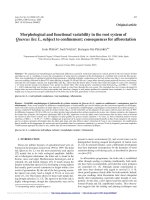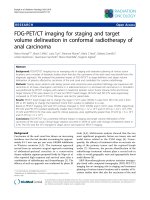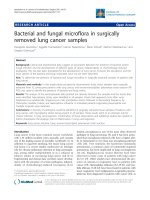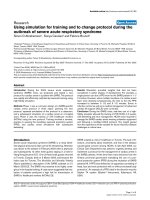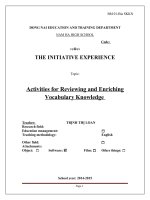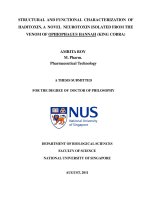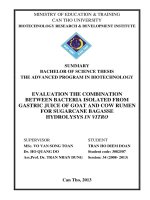Plant growth-promoting activities for bacterial and fungal endophytes isolated from medicinal plant of Teucrium polium L.
Bạn đang xem bản rút gọn của tài liệu. Xem và tải ngay bản đầy đủ của tài liệu tại đây (1020.63 KB, 9 trang )
Journal of Advanced Research 8 (2017) 687–695
Contents lists available at ScienceDirect
Journal of Advanced Research
journal homepage: www.elsevier.com/locate/jare
Original Article
Plant growth-promoting activities for bacterial and fungal endophytes
isolated from medicinal plant of Teucrium polium L.
Saad El-Din Hassan
Botany and Microbiology Department, Faculty of Science, AL-Azhar University, Nasr City, Cairo 11884, Egypt
g r a p h i c a l a b s t r a c t
a r t i c l e
i n f o
Article history:
Received 17 June 2017
Revised 23 August 2017
Accepted 9 September 2017
Available online 11 September 2017
Keywords:
Antimicrobial activity
Endophyte
IAA
Phosphate solubilization
Plant growth promoting bacteria
Teucrium polium L.
Zea mays L.
a b s t r a c t
Bacterial and fungal endophytes are widespread inhabitants inside plant tissues and have been shown to
assist plant growth and health. However, little is known about plant growth-promoting endophytes
(PGPE) of medicinal plants. Therefore, the aims of this study were to identify bacterial and fungal endophytes of Teucrium polium and to characterize plant growth-promoting (PGP) properties of these endophytes. Seven bacterial endophytes were isolated and identified as Bacillus cereus and Bacillus subtilis,
where five endophytic fungi were obtained and assigned to Penicillium chrysogenum and Penicillium crustosum. The isolated endophytes differentially produced indole acetic acid (IAA) and ammonia, and in
addition to their enzymatic and antimicrobial activities, they exhibited variable capacity for phosphate
solubilization. In order to investigate the effect of endophytes on plant growth, four representative endophytes and their consortiums were selected concerning to their potential ability to promote plant growth.
The results indicated that microbial endophytes isolated from medicinal plants possessing a vital role to
improve plant growth and could be used as inoculants to establish a sustainable crop production system.
Ó 2017 Production and hosting by Elsevier B.V. on behalf of Cairo University. This is an open access article
under the CC BY-NC-ND license ( />
Introduction
The long-term approaches of organic and inorganic fertilizers
beside to pesticides are urgently required for the enhancement of
Peer review under responsibility of Cairo University.
E-mail addresses: ,
crop production [1]. Notably, these applications negatively
influence on soil quality and contribute to environmental pollution
[2]. Concerning to minimize the detrimental effects of the
conventional techniques of agriculture, innovative methods based
on microbial inoculation are recently gaining more interest. Plants
and microorganisms form a symbiotic association with benefits for
/>2090-1232/Ó 2017 Production and hosting by Elsevier B.V. on behalf of Cairo University.
This is an open access article under the CC BY-NC-ND license ( />
688
S.E.-D. Hassan / Journal of Advanced Research 8 (2017) 687–695
both partners. More importantly, plant-microbe symbiosis
influence on plant growth and health which effectively ameliorates
agricultural traits and improve soil quality and nutrient cycling
[3–5].
Plant growth-promoting endophytes (PGPE) inhabit plant
tissues and the close linkage of endophytes inside plant tissues
facilitates nutrients exchange and enzymes activity [6,7]. The distribution of growth-promoting hormones produced by endophytic
microorganisms towards plant tissues positively promotes plant
growth [8]. Endophytes possess vital ability to mobilize insoluble
phosphate and provide nitrogen to their host plants [9,10]. Microbial endophytes colonize plant tissues without symptomatic behaviour and consequently they compete with other microbial
pathogens on the same ecological niches. Therefore, the established plant-endophyte association improves plant health via different mechanisms displayed by endophytes and potentially
contributes the protection of plant host against microbial pathogenesis [11]. PGPE produce various bioactive compounds with several biological activities which can be directly or indirectly
described as plant growth-promoting (PGP) agents. Approximately
most of the plants harbour endophytes interior their tissues; however, available information on PGPE and their biological activities
is not equivalent to the high distribution of endophytes. A superior
comprehension of the native endophytes of plants may help clarify
their capacities and potential in enhancing plant growth and establishing a sustainable system for crop production.
Teucrium polium L. is a wild plant belonging to family Lamiaceae
and naturally found in Saint Katherine Protectorate which is a part
from the Sinai Peninsula in Egypt. Saint Katherine Protectorate is
characterized by extremely arid climate and it is located at average
of 1500–2000 m above mean sea level [12]. It has been reported
that T. polium plant used in traditional medicine as antimicrobial
and antiseptic; more recently, several bioactive compounds such
as terpenoids and flavonoids have been isolated from T. polium
and their pharmaceutical uses as antimicrobial, antioxidant, and
anticancer have been investigated [13]. Although the ecological
and biological importance of T. polium as a medicinal plant inhabitant in unique environmental area, microbial endophytes of this
plant have been yet investigated. A previous study focused on
the isolation of fungal endophytes from T. polium which occurs in
Saint Katherine Protectorate [12]; screening antimicrobial activities of these fungal endophytes have only been examined. Till
now, no published study has been inspected plant growthpromoting activities of microbial endophytes correlated to this
medicinal plant in natural arid habitats. Discovery the presence
of endophytic bacteria and fungi in T. polium could be biotechnologically applicable; therefore, hypothesis of the current study is
that microbial endophytes of this medicinal plant are promising
bio-inoculants for plant growth promotion trait. The outline of this
study concentrates on the isolation, molecular identification, and
characterization of putative bacterial and fungal endophytes
related to medicinal plant of T. polium which naturally occur in arid
conditions of Saint Katherine Protectorate. More specificity, verification for plant growth-promoting properties of these microbial
isolates such as enzymatic production, antimicrobial activity, IAA
and ammonia production, and P solubilization were evaluated to
test their influence on the biomass production of maize plant as
an important economical crop.
Material and methods
Plant sampling and microbial endophytes isolation
Medicinal plant of Teucrium polium L. (family Lamiaceae) was
collected from Wadi al-Zwatin (lat 28.539290° to 28.53919° N;
long 33.930784° to 33.92044° E), Saint Katherine Protectorate,
Sinai Peninsula, Egypt. The plant leaves were washed by running
tap water and subsequently by sterile distilled water, then surface
sterilized by ethanol 70% for 1 min, sodium hypochlorite 2.5% for
5 min, ethanol 70% for 30 s, and finally washed in sterile distilled
water for 3 times. The last washing water was plated onto nutrient
agar, Czapek Dox (CD) agar, and potato dextrose agar (PDA) media.
Additionally, any microbial DNA in the last washing water was
detected by the amplification of bacterial rRNA genes or fungal
ITS fragments. The success of surface sterilization method was confirmed by the absence of microbial DNA amplification and also
when no microbial growth was detected on the cultural media.
Bacterial endophytes were isolated from the sterilized plant leaves
[14] on Luria-Bertani (LB) and nutrient agar media, where fungal
endophytes were isolated on PDA and CD media [6]. The bacterial
and fungal growth from the internal tissues or crushed segments
were checked for purity, transferred to fresh cultural slants and
stored at 4 °C for further study.
Molecular identification of endophytes
Molecular identification was carried out based on bacterial 16S
rRNA gene and fungal internal transcribed spacer (ITS) rDNA rejoins
amplification and sequence analyses. Genomic DNA was extracted
according to the method of Miller et al. [15]. Bacterial 16S rRNA
genes were amplified using the genomic DNA as template and bacterial universal primers of 27 f (5-GAGTTTGATCACTGGCTCAG-3)
and 1492 r (5-TACGGCTACCTTGTTACGACTT-3) [16]. Fungal ITS
rDNA rejoins were amplified by the primers of ITS1 f
(5-CTTGGTCATTTAGAGGAAGTAA-3) and ITS4 (5-TCCTCCGCTTATT
GATATGC-3) [17]. The PCR mixture contained: 1 Â PCR buffer,
0.5 mM MgCl2, 2.5 U Taq DNA polymerase (QIAGEN, Germantown,
MD 20874, USA), 0.25 mM dNTP, 0.5 lM of each primer, and 1 ll
of extracted genomic DNA. The PCR was performed in a DNA Engine
Thermal Cycler (PTC-200, BIO-RAD, USA) with 94 °C for 3 min, followed by 30 cycles of 94 °C for 30 s, 55 °C for 30 s, and 72 °C for
1 min, followed by a final extension performed at 72 °C for 10 min.
The PCR products were checked for the expected size on 1% agarose
gel and were sequenced at the Genome Quebec Innovation Center
Facility (Montreal, Canada) with the two primers. The retrieved bacterial sequences at this study have been deposited in GenBank under
accession numbers from KY905357 to KY905363, where the accession numbers of fungal ITS sequences are KY906184-KY906188.
The sequences were compared against the GenBank database using
the NCBI BLAST program. Multiple sequence alignment was done
using ClustalX 1.8 software package (http://wwwigbmc.u-strasbg.
fr/BioInfo/clustalx) and a phylogenetic analysis was constructed
by the neighbor-joining method using MEGA (Version 6.1) software,
with confidence tested by bootstrap analysis (1000 repeats).
Screening of plant growth-promoting properties of endophytes
Microbial endophytic isolates were screened for phosphate solubilization by procedure of Jasim et al. [18] using Pikovskaya medium and bromophenol blue as indicator. The ability of endophytic
isolates to produce ammonia was assessed using Nesseler’s reagent
in peptone liquid media [19]. Where, the intensity of colour change
indicates the endophytes capacity for ammonia production.
Produced extracellular enzymes by bacterial endophytes were
assessed with conducting the tested substrates into a mineral salt
(MS) media and inoculating the media with bacterial isolates. The
production of extracellular enzymes by fungal endophytes were
detected by growing on Yeast-Malt (YM) agar media (YM: 10 g/L
glucose, 5 g/L peptone, 3 g/L yeast extract, 3 g/L malt extract,
1.5% agar, pH 6.7) and placing 5 mm fungal plugs on the YM agar
media supplemented with dissolved and specific indicative sub-
S.E.-D. Hassan / Journal of Advanced Research 8 (2017) 687–695
strates. Amylase, cellulose, protealase, pectinase, and xylanase
activities of endophytes were evaluated by growing the endophytic
isolates on media supplemented with 1% of soluble starch, cellulose or carboxy-methylcellulose (CMC), gelatine, Pectin, and xylan,
respectively. The appearance of clear zone was measured after
adding specific reagents (iodine, acidic mercuric chloride, hexadecyl trimethyl ammonium bromide, and absolute ethyl alcohol to
detect the amylolytic and cellulolytic, proteolytic, pectinolytic,
xylanolytic activities, respectively) and used as indicator for extracellular enzymatic activities [20].
To test the antimicrobial activity of endophytes, the bacterial
isolates were cultured in nutrient broth medium for 6 days at
35 ± 2 °C on a shaker at 180 rpm. Where, fungal isolates were cultured in Malt extract liquid medium for 10 days at 28 °C on a shaker at 180 rpm. Crude fermentation broth were blended
thoroughly and centrifuged at 4000 rpm for 5 min. Liquid supernatant was extracted with an equal volume of ethyl acetate thrice.
The organic solvent extract was then evaporated and the crude
extracts were dissolved in dimethyl sulfoxide (DMSO) and used
for antimicrobial screening assay by well diffusion method [21].
The coded test organisms used for antimicrobial assay were;
Gram-positive bacteria: Staphylococcus aureus, ATCC 6538 and
Bacillus subtilis, ATCC 6633; Gram-negative bacteria: Escherichia
coli, ATCC 8739; Pseudomonas aeruginosa, ATCC 9027 and Salmonella typhimurium ATCC 14028; and yeast strain of Candida albicans, ATCC 10231. Antimicrobial activity of the endophytic crude
extracts was determined by the method previously described [20].
The ability of endophytes to produce IAA was determined with
Salkowski’s reagent and different concentrations of tryptophan
(1, 2 and 5 mg mLÀ1) or without tryptophan according to the colorimetric method previously described [22]. Moreover, the highest
producers for IAA were selected and subjected to another assay for
detection the amount of IAA at 2 days interval within 14 days in
the presence of optimum tryptophan concentration 5 mg mLÀ1.
Effect of the endophytic inoculation on maize growth
Two bacterial isolates of Tp.1B and Tp.6B, a bacterial consortium formed a mix of Tp.1B-Tp.6B, two fungal isolates Tp.2F, and
Tp.5F, and a fungal inoculum formed a mix of Tp.2F-Tp.5F were
selected for their better PGP activities in order to test the effect
of endophytic inoculation on root length and the biomass productionh of maize plant. The seeds were surface disinfected by soaking
in 2.5% sodium hypochlorite for 5 min, 70% ethanol for 1 min, and
then washed by sterile distilled water for 5 times. Bacterial pure
cultures of Tp.1B and Tp.6B were grown in nutrient broth at
35 ± 2 °C on a shaker at 180 rpm. The bacterial cultures were
diluted in sterilized distilled water to reach final concentration of
106–8 CFU mLÀ1 [14]. Fungal isolates of Tp.2F and Tp.5F were inoculated in CD broth at 28 °C on a shaker at 180 rpm for 7 days [20].
Pregerminated and surface-disinfected seeds were incubated with
bacterial or fungal suspensions at room temperature for 6 h, the
broth without microbial inoculation was used to treat control
seeds. Control and treated seeds were placed in sterilized Petri
dishes with wet sterilized filter papers and incubated at room temperature for 5 days in dark to measure the root length. The experimental treatments were conducted in 5 replications, in which 10
seeds per each replicated unit.
A pot experiment greenhouse was carried out to evaluate the
effect of endophytic inoculation on maize growth. A completely
randomized design was set up including the inoculation with
endophytes of Tp.1B, Tp.6B, Tp.2F, and Tp.5F plus microbial consortiums of Mix.1-6B (bacterial isolates of Tp.1B and Tp.6B) and
Mix.2-5F (fungal isolates Tp.2F, and Tp.5F). The disinfected seeds
were germinated on wet sterilized filter papers and incubated at
room temperature for 5 days in dark. The equal sized seedling were
689
chosen and immersed in bacterial or fungal suspensions at room
temperature for 2 h [14], where control seedling were treated by
free-bacterial or free-fungal suspensions. Control and treated seedling were transplanted in 1 L plastic pots filled with 900 g of sterilized soil-sand mixture, 3 seedlings per pot. A loamy soil (sand
76.8%, silt 10.9%, and clay 12.2%) with chemical characters of: pH
= 6, CEC (mEq per 100 g) = 15, organic matter = 5.2%, 24 mg kgÀ1
P, 15.1 mg kgÀ1 K, 186.4 mg kgÀ1 Na, 27.3 mg kgÀ1 Ca, and
134.4 mg kgÀ1 Cl was used. This soil was air-dried, sieved with a
2 mm sieve, and autoclaved twice for one hour at 121 °C. For further successful inoculation, one-week-old seedlings were treated
with 10 mL of microbial suspensions [23]. Control seedling were
loaded by free-bacterial or free-fungal suspensions. Plants were
grown in a greenhouse with temperature 25–30 °C and irrigated
by tap water without adding any fertilization. After 30 days plants
were harvested, shoot and root systems were separated, and roots
were washed carefully with tap water to remove soil particles
attached with roots. The shoots and roots fresh weight were measured, and then oven dried for 72 h at 60 °C and weighted to determine the dry weights.
Statistical analysis
Data were statistically analyzed by SPSS v17, one-way analysis
of variance (A��������������������������������������������������������������������������������������������������������������������������������������������������������������������������������������������������������������������������������������������������������������������������������������������������������������������������������������������������������������������������������������������������������������������������������������������������������������������������������������������������������������������������������������������������������������������������������������������������������������������������������������������������������������������������������������������������������������������������������������������������������������������������������������������������������������������������������������������������������������������������������������������������������������������������������������������������������������������������������������������������������������������������������������������������������������������������������������������������������������������������������������������������������������������������������������������������������������������������������������������������������������������������������������������������������������������������������������������������������������������������������������������������������������������������������������������������������������������������������������������������������������������������������������������������������������������������������������������������������������������������������������������������������������������������������������������������������������������������������������������������������������������������������������������������������������������������������������������������������������������������������������������������������������������������������������������������������������������������������������������������������������������������������������������������������������������������������������������������������������������������������������������������������������������������������������������������������������������������������������������������������������������������������������������������������������������������������������������������������������������������������������������������������������������������������������������������������������������������������������������������������������������������������������������������������������������������������������������������������������������������������������������������������������������������������������������������������������������������������������������������������������������������������������������������������������������������������������������������������������������������������������������������������������������������������������������������������������������������������������������������������������������������������������������������������������������������������������������������������������������������������������������������������������������������������������������������������������������������������������������������������������������������������������������������������������������������������������������������������������������������������������������������������������������������������������������������������������������������������������������������������������������������������������������������������������������������������������������������������������������������������������������������������������������������������������������������������������������������������������������������������������������������������������������������������������������������������������������������������������������������������������������������������������������������������������������������������������������������������������������������������������������������������������������������������������������������������������������������������������������������������������������������������������������������������������������������������������������������������������������������������������������������������������������������������������������������������������������������������������������������������������������������������������������������������������������������������������������������������������������������������������������������������������������������������������������������������������������������������������������������������������������������������������������������������������������������������������������������������������������������������������������������������������������������������������������������������������������������������������������������������������������������������������������������������������������������������������������������������������������������������������������������������������������������������������������������������������������������������������������������������������������������������������������������������������������������������������������������������������������������������������������������������������������������������������������������������������������������������������������������������������������������������������������������������������������������������������������������������������������������������������������������������������������������������������������������������������������������������������������������������������������������������������������������������������������������������������������������������������������������������������������������������������������������������������������������������������������������������������������������������������������������������������������������������������������������������������������������������������������������������������������������������������������������������������������������������������������������������������������������������������������������������������������������������������������������������������������������������������������������������������������������������������������������������������������������������������������������������������������������������������������������������������������������������������������������������������������������������������������������������������������������������������������������������������������������������������������������������������������������������������������������������������������������������������������������������������������������������������������������������������������������������������������������������������������������������������������������������������������������������������������������������������������������������������������������������������������������������������������������������������������������������������������������������������������������������������������������������������������������������������������������������������������������������������������������������������������������������������������������������������������������������������������������������������������������������������������������������������������������������������������������������������������������������������������������������������������������������������������������������������������������������������������������������������������������������������������������������������������������������������������������������������������������������������������������������������������������������������������������������������������������������������������������������������������������������������������������������������������������������������������������������������������������������������������������������������������������������������������������������������������������������������������������������������������������������������������������������������������������������������������������������������������������������������������������������������������������������������������������������������������������������������������������������������������������������������������������������������������������������������������������������������������������������������������������������������������������������������������������������������������������������d for active compounds of T. polium, in particular terpenoids and flavonoids [13].
This plant could has different physiological and biological components that permit it to thrive in arid area with that valuable importance, and maybe some portion of its versatile adaptation would
depend leastwise on its capacity to set up viable relationship with
microbial endophytes. To our knowledge, this is the first report
concerning the isolation of putative bacterial and fungal endophytes associated with this medicinal plant and characterization
these endophytes as PGPE.
692
S.E.-D. Hassan / Journal of Advanced Research 8 (2017) 687–695
Table 3
Antimicrobial activities of microbial endophytes.
Microbial isolates
Tp.1B
Tp.2B
Tp.3B
Tp.4B
Tp.5B
Tp.6B
Tp.7B
Tp.1F
Tp.2F
Tp.3F
Tp.4F
Tp.5F
Diameter of clear zone (mm)
P. aeruginosa
S. typhi
E. coli
S. aureus
B. subtilis
C. albicans
16.7 ± 0.3a
0f
13.7 ± 0.3b
13.3 ± 0.8b
12.7 ± 0.6b
16.6 ± 0.3a
0f
9.3 ± 0.4d
11.7 ± 0.4c
8.7 ± d
7.3 ± e
13.3 ± 0.3b
11.3 ± 0.3b
8.6 ± 0.3c
8.3 ± 0.3c
0e
0e
19.3 ± 0.7a
7.3 ± 0.4d
0e
0e
0e
0e
0e
8.3 ± 0.3b
0c
0c
0c
0c
15.3 ± 0.3a
0c
0c
0c
0c
0c
0c
0c
0c
0c
0c
0c
20.0 ± 1.1a
0c
0c
0c
0c
0c
14.7 ± 0.3b
6.00.6b
0d
0d
3.7 ± 0.1c
0d
15.7 ± 0.3a
0d
0d
7.0 ± 1.1b
0d
0d
14.6 ± 0-3a
0b
0b
0b
0b
0b
12.6 ± 0.3a
0b
0b
0b
0b
0b
0b
Tested microorganisms are, Gram positive bacteria: Staphylococcus aureus ATCC 6538 (S. aureus), Bacillus subtilis ATCC 6633 (B. subtilis); Gram negative bacteria: Escherichia
coli ATCC 8739 (E. coli), Pseudomonas aeruginosa ATCC 9027 (P. aeruginosa) and Salmonella typhimurium ATCC 14028 (S. typhimurium); unicellular fungi: Candida albicans ATCC
10231 (C. albicans).
Values within the same column with different letters are significantly different (P 0.05) by LSD test, values are means ± SE (n = 6).
Table 4
Extracellular enzymatic activities of microbial endophytes.
Microbial isolates
Tp.1B
Tp.2B
Tp.3B
Tp.4B
Tp.5B
Tp.6B
Tp.7B
Tp.1F
Tp.2F
Tp.3F
Tp.4F
Tp.5F
Diameter of clear zones (mm)
Amylase
Pectinase
CMCase
Cellulase
Xylanase
Gelatinase
20.7 ± 0.6a
6.7 ± 0.3c
7.0 ± 0.5c
6.3 ± 0.9c
6.1 ± 0.6c
9.3 ± 0.6b
6.3 ± 0.3c
5.3 ± 0.3d
0e
5.4 ± 0.3d
0e
22.3 ± 1.5a
15.7 ± 0.3d
12.7 ± 0.3f
13.3 ± 0.8e
13 ± 0.5e
13.3 ± 1.3e
14.7 ± 0.7d
12.6 ± 0.3f
31.0 ± 0.5b
36.7 ± 0.8a
24.0 ± 0.6c
23.0 ± 1.2c
37 ± 1a
25.3 ± 0.3d
12.0 ± 0.5 g
13.0 ± 0.7f
10.3 ± 0.3 h
10.3 ± 0.9 h
15.3 ± 0.3e
8.6 ± 0.3i
30.0 ± 0.6c
38.7 ± 0.7b
25.0 ± 0.5d
26 ± 2d
41 ± 1a
30.3 ± 0.3b
14.3 ± 0.3 g
13.3 ± 0.9 g
14.0 ± 1.1 g
13.6 ± 0.7 g
20 ± 1.2f
13.7 ± 0.3 g
28.6 ± 0.3c
34.7 ± 0.7a
25.7 ± 0.6d
22.0 ± 0.5e
36.3 ± 1.2a
25.3 ± 0.3c
10.6 ± 0.8f
10.3 ± 0.9f
11.7 ± 0.7f
10.3 ± 0.9f
14.7 ± 0.3e
11.0 ± 0.6f
23.0 ± 0.5d
31.3 ± 0-7b
22.3 ± 0.8d
22.4 ± 0.9d
38 ± 1.2a
22.7 ± 0.3b
17.7 ± 0.6c
14.0 ± 0.5d
12.3 ± 0.3e
17.7 ± 0.3c
23.3 ± 2.4b
17.3 ± 0.3c
24.6 ± 3.3b
34.7 ± 0.9a
24.0 ± 0.6b
23.3 ± 0.3b
33.3 ± 0.8a
Values within the same column with different letters are significantly different (P
In the current study, seven bacterial and five fungal endophytes
were isolated from medicinal plant of T. polium. Depending on PGP
traits, four representative microbial isolates were selected and
their potential role for PGP was determined. Genotypic characterization of bacterial isolates based on 16S rRNA sequences analysis
showed that the isolated strains were classified in the genus Bacillus. The predominance of Bacillus genus as endophytic bacteria has
been isolated from ginseng (Panax ginseng C.A. Meyer) [24], Lonicera japonica [25], and soybean (Glycine max L.) [26]. Hanna
et al., [27] reported also the frequency of genus Bacillus in several
perennial and annual plants found in north Sinai deserts, Egypt.
Bacillus is one of the most commonly found as bacterial endophytes [28,29]. Our results are in line with those reported that
Bacillus populations have been widely found in various medicinal
plants such as Glycyrrhiza spp., Pinellia ternate, Lycium chinense,
Digitalis purpurae, Leonurus heterophyllus, Bletilla striata, Belamcanda chinases, P. pedatisecta, and Taxus yunnanensis [30–32].
Phylogentic analysis of fungal ITS sequences showed the taxonomic status of fungal endophytes to the genus Penicillium. Selim
et al. [12] obtained 6 fungal endophytes namely Aspergillus niger,
Alternaria alternate, Nigrospora sphaerica, Penicillium corylophilum,
Penicillium chrysogenoum, and white sterile mycelia isolated from
T. polium. Nicoletti et al. [33] reviewed the endophytism ubiquitous
of penicillium genus in several woody plants; also, different endophytic penicillium species were isolated from coffee plants [34].
Broad screening techniques based on culture-dependent or independent methods to determine the endophyte-plant association
0.05) by LSD test, values are means ± SE (n = 6).
is required in order to understand the specific relationship
between plants and endophytes. In this direction, the determination of the plant-associated endophytes would be useful for the
biotechnological applications of endophytes as biocontrol or plant
growth-promoting agents.
Microbial endophytes directly promote plant growth through
the production of plant hormones particularly IAA or phosphorus
mobilization. Indirect plant growth promotion caused by endophytes includes antimicrobial activities and ammonia production
or the synthesis of degrading enzymes which significantly inhibit
pathogenic microorganisms.
‘In addition to the role of IAA in plant growth regulation, microbial IAA integrates symbiotic interaction between plants and
microorganisms [8]. The results revealed that the highest IAA concentration ranges of 19.9–63.5 mg mLÀ1 and 4.1–23.4 mg mLÀ1 were
registered for fungal endophyte of Tp.5F and bacterial endophyte
Tp.1B, respectively; suggesting that the ability of these endophytes
to stimulate root development and promote plant growth. It has
been observed that root growth regulation is the main phenotypic
character mediated by IAA [35,36]; also, IAA produced by bacterial
endophytes positively affected root development of tomato plants
[37]. IAA has a crucial role in plant root formation and cell division
stimulation even though under harsh environmental condition
[36,38]. Data analysis showed that increased IAA concentration
significantly accomplished with increased tryptophan levels. Interestingly, the isolated endophytes had capacity of IAA synthesis
without tryptophan supplementation which reflects the conditions
693
S.E.-D. Hassan / Journal of Advanced Research 8 (2017) 687–695
inside plant tissues, where IAA synthesis occurs with free tryptophan levels. In fact, our results supposed that microbial endophytes obtained in this study, potentially regulate plant growth
by means of IAA synthesis. In addition, different endophytic microbial species achieved variable capacity to produce IAA levels in a
manner that differentially affected plant growth. Previously, it
was observed that IAA produced by bacterial endophytes stimulate
plant growth and increase root area and subsequently enhance
nutrients uptake from the soil [39]. Dawwam et al. [40] showed
that bacterial endophytes produced different amount of IAA ranged
from 0.36 mg mL to 14.77 mg mLÀ1 and from 0.6 mg mLÀ1 to
10.73 mg mLÀ1. Three endophytic fungi of Penicillium chrysogenum,
Alternaria alternate, and Sterile hyphae were isolated from Asclepias
sinaica and produce approximately high IAA ranges of 100–
160 mg mLÀ1 and exhibited a significant increase in root length of
maize plants [20].
Microbial phosphate solubilization is a promising tool as biofertilizers application; the results showed that microbial endophytes
of Tp.2F, Tp.5F, Tp.6B, and Tp1B displayed the highest indices for
phosphate solubilization which is the main contributor for
increased plant growth. Karagöz et al. [41] revealed that secretion
of organic acids is one of the main mechanisms which enable bacteria to mobilize the insoluble phosphate. Another mechanism by
which the phosphorus solubilizing bacteria help plants to access
the P is through excretion of protons or enzymatic production that
solubilize insoluble forms of P or mineralize organic phosphorus
and render it available to the plants for uptake [42,43]. Inoculation
with endophytes increased phosphate solubilization and significantly improved plant growth [44]. On the other hand, microbial
production of ammonia potentially provides plants with their
demand of nitrogen and not only considers a mechanism for plant
growth stimulation but also increases the plant defence against
pathogens colonization. Frequent nitrogen input in the soil mainly
increases the cost of crop production; therefore, production of
ammonia by endophytes is a desirable trait for plant growth promotion and soil fertility [45].
Enzymatic and antimicrobial activities are indirect mechanisms exhibited by endophytes for plant growth promotion.
The results demonstrated that all isolated endophytes produced
cellulose, pectinase, xylanase, and protease enzymes. These
70
IAA concentration (µg/mL)
60
Ctrl
Tp.1B
Tp.6B
50
40
30
20
*
*
*
*
*
*
10
12
14
*
*
*
10
12
14
10
0
2
4
6
8
Time (days)
70
IAA concentration (µg/mL)
60
Ctrl
Tp.2F
Tp.5F
*
50
*
40
30
*
*
20
10
0
2
4
6
8
Time (days)
Fig. 3. IAA production by the most potent of: (a) bacterial isolates (b) fungal
isolates; in the presence of 5 mg/mL tryptophan and at different interval time
course. At each time, asterisk denotes significant difference between control and
endophytic isolates at significant level of (P 0.05) as determined by LSD test.
Values are means ± SE (n = 6).
Table 5
Effect of bacterial inoculations on the growth properties of maize plants.
Root length (cm)
Bacterial treatments
Control
Tp.1B
Tp.6B
Mix.1-6B
7.5 ± 0.85c
11.5 ± 0.57a
10.45 ± 0.59a
11.85 ± 1.2a
Fresh weight (mg)
Dry weight (mg)
Shoot
Root
Shoot
Root
535.8 ± 37.2b
647.5 ± 22.2a
636.1 ± 16.0a
643.0 ± 15.6a
1011.6 ± 56.0b
1137.3 ± 30.8a
1143.3 ± 18.6a
1169.8 ± 19.3a
80.5 ± 3.2c
129.1 ± 4.0 a
110.7 ± 3.7b
129.3 ± 6.9a
222.3 ± 8.0c
328.3 ± 5.2a
310.8 ± 4.8b
332.0 ± 4.4a
Values within the same column with different letters are significantly different (P 0.05) by LSD test, values are means ± SD (n = 6–10). Control is non bacterial inoculated
plants; Mix.1-6B, bacterial consortium formed of a mix of bacterial isolates Tp.1B and Tp.6B.
Table 6
Effect of fungal inoculations on the growth properties of maize plants.
Root length (cm)
Fungal treatments
Control
Tp.2F
Tp.5F
Mix.2-5F
Fresh weight (mg)
Shoot
b
7.8 ± 0.78
12.05 ± 1.06a
11.8 ± 1.13a
12.8 ± 0.63a
Dry weight (mg)
Root
a
559.5 ± 13.1
680.8 ± 8.4b
732.3 ± 5.7a
727.6 ± 14.6a
Shoot
d
1012 ± 6.8
1108 ± 44.7c
1225.8 ± 10.1b
1247.3 ± 36.0a
Root
c
85 ± 3.2
133.1 ± 1.9b
146.5 ± 1.8a
147.8 ± 2.6a
222 ± 5.2c
333.7 ± 16.7b
346.2 ± 24.9a
330.5 ± 8.4b
Values within the same column with different letters are significantly different (P 0.05) by LSD test, values are means ± SD (n = 6–10). Control is non fungal inoculated
plants; Mix.2-5F, fungal consortium formed of a mix of fungal isolates Tp.2F and Tp.5F.
694
S.E.-D. Hassan / Journal of Advanced Research 8 (2017) 687–695
enzymes are responsible for hydrolytic actions which enable
endophytes to penetrate plant tissue and establish symbiotic
relationship between endophytes and host plant. The enzymatic
activities of endophytes provide their host plants with a protection against pathogenic microorganisms through cell wall
hydrolysis of pathogens [46]. Although endophytes obtain their
nutrients from plant by enzymes secretion, these extracellular
enzymatic activities improve plant nutrition and imply in plant
senescence by protein and polysaccharides degradation [47]. In
another view regarding to biotechnology, amylolytic and proteolytic enzymes of endophytes are being investigated to improve
industrial processes for polysaccharides and protein biodegradation [48].
Suppression of microbial growth by crude filtrate of endophytes
was determined in order to investigate antimicrobial activity of
endophytes [49]. Results showed that all isolated endophytes displayed significant inhibition zone against at least one of the tested
microbial pathogens. Therefore, endophytes with PGP characters
integrated with antimicrobial actions potentially useful for crop
production. Our results suggest the ability of these endophytes as
biocontrol agents to inhibit the growth of pathogenic microorganisms. For biotechnological application of endophytes as biocontrol,
the selection of microbial inoculants in regard to their direct ability
to promote plant growth is crucial. However, other mechanisms
which enable microbial inoculants to establish mutualism with
plants without severe any detrimental symptoms are necessary
required [50].
Endophytes localize inside plant tissues, that close linkage facilitates mutualism between endophytes and plant. Since endophytes
are acting as producers for several bioactive compounds through
various mechanisms, they offer several benefits significantly affect
plant growth. Advantageously, being endophytes colonize plant
tissues with symptomless appearance; they compete with pathogens on the same habitat and positively influence plant health. In
a greenhouse experiment, the endophytes inoculated plants displayed better shoot and root dry weights compared to uninoculated plants. In addition, the representative isolates significantly
increased plant root length than found for uninoculated plants.
Endophytes isolated from plant and their inoculation enhanced
the growth of other plants was previously found, where bacterial
endophytes isolated from Lonicera japonica improved the growth
of wheat plants, respectively [25]. Using microbial consortium
with different endophytic isolates which have various PGP characters can probably integrated together and improve plant growth
and health by employment diverse mechanisms within different
periods of the plant life cycle [45]. Obviously, putative endophytes
isolated in this study exhibited multiple routes to improve plant
growth; moreover, better performance of inoculated plants grown
in soil suggests the probable competition of isolated endophytes
with soil microorganisms. However, neither this competition nor
endophytic capacities of representative isolates in the tested plants
have yet been proven in our study.
Conclusions
The present study revealed that medicinal plant of T. polium
which naturally inhabitant arid conditions, is an ecological niche
for diverse putative bacterial and fungal endophytes. These endophytes displayed various direct and indirect mechanisms for plant
growth promoting without symptomatic injury; therefore, inoculation of maize plants with endophytic representative isolates stimulated plant growth and increased biomass production compared
to uninoculated plants. This study suggests the potential application of these endophytes in agricultural traits could results in ameliorate plant production and health and in another way may lead to
improve soil quality and fertility. However, further endophytes isolation and repetitive field experiments are required to support the
current finding.
Conflict of interest
The author has declared no conflict of interest.
Compliance with Ethics Requirements
This article does not contain any studies with human or animal
subjects.
Acknowledgements
This work was conducted in: Microbial Biotechnology Laboratories, and Botanical Garden at Botany and Microbiology Department, Faculty of Science, AL-Azhar University. The author would
like to thank Prof. Dr. Azab M. (Faculty of Science, AL-Azhar University) for his discussion and comments which greatly improved the
manuscript.
Reference
[1] Bokhtiar SM, Sakurai K. Effect of application of inorganic and organic fertilizers
on growth, yield and quality of sugarcane. Sugar Tech 2005;7(1):33–7.
[2] Aktar MW, Sengupta D, Chowdhury A. Impact of pesticides use in agriculture:
their benefits and hazards. Interdiscip Toxicol 2009;2(1):1–12.
[3] Khan AL, Waqas M, Khan AR, Hussain J, Kang S-M, Gilani SA, et al. Fungal
endophyte Penicillium janthinellum LK5 improves growth of ABA-deficient
tomato under salinity. World J Microbiol Biotechnol 2013;29(11):2133–44.
[4] Karthik C, Oves M, Thangabalu R, Sharma R, Santhosh SB, Indra Arulselvi P.
Cellulosimicrobium funkei-like enhances the growth of Phaseolus vulgaris by
modulating oxidative damage under Chromium(VI) toxicity. J Adv Res 2016;7
(6):839–50.
[5] Puri A, Padda KP, Chanway CP. Seedling growth promotion and nitrogen
fixation by a bacterial endophyte Paenibacillus polymyxa P2b–2R and its GFP
derivative in corn in a long-term trial. Symbiosis 2016;69(2):123–9.
[6] Khan AR, Ullah I, Waqas M, Shahzad R, Hong S-J, Park G-S, et al. Plant growthpromoting potential of endophytic fungi isolated from Solanum nigrum leaves.
World J Microbiol Biotechnol 2015;31(9):1461–6.
[7] Murphy BR, Doohan FM, Hodkinson TR. Yield increase induced by the fungal
root endophyte Piriformospora indica in barley grown at low temperature is
nutrient limited. Symbiosis 2014;62(1):29–39.
[8] Lin L, Xu X. Indole-3-acetic acid production by endophytic streptomyces sp.
En-1 isolated from medicinal plants. Curr Microbiol 2013;67(2):209–17.
[9] Matsuoka H, Akiyama M, Kobayashi K, Yamaji K. Fe and P solubilization under
limiting conditions by bacteria isolated from Carex kobomugi Roots at the
Hasaki Coast. Curr Microbiol 2013;66(3):314–21.
[10] Shi Y, Lou K, Li C. Growth promotion effects of the endophyte Acinetobacter
johnsonii strain 3–1 on sugar beet. Symbiosis 2011;54(3):159–66.
[11] Malhadas C, Malheiro R, Pereira JA, de Pinho PG, Baptista P. Antimicrobial
activity of endophytic fungi from olive tree leaves. World J Microbiol
Biotechnol 2017;33(3):46.
[12] Selim KA, El-Beih AA, AbdEl-Rahman TM, El-Diwany AI. Biodiversity and
antimicrobial activity of endophytes associated with Egyptian medicinal
plants. Mycosphere 2011;2(6):669–78.
[13] Bahramikia S, Yazdanparast R. Phytochemistry and medicinal properties of
Teucrium polium L. (Lamiaceae). Phytother Res 2012;26(11):1581–93.
[14] Zhao S, Zhou N, Zhao Z-Y, Zhang K, Wu G-H, Tian C-Y. Isolation of endophytic
plant growth-promoting bacteria associated with the halophyte Salicornia
europaea and evaluation of their promoting activity under salt stress. Curr
Microbiol 2016;73(4):574–81.
[15] Miller DN, Bryant JE, Madsen EL, Ghiorse WC. Evaluation and optimization of
DNA extraction and purification procedures for soil and sediment samples.
Appl Environ Microbiol 1999;65(11):4715–24.
[16] Lane DJ. 16S/23S rRNA sequencing. In: Stackebrandt E, Goodfellow M, editors.
Nucleic Acids Techniques in Bacterial Systematics. Chichester, United
Kingdom: John Wiley & Sons; 1991. p. 115–47.
[17] White TJ, Bruns T, Lee S. Amplification and direct sequencing of fungal
ribosomal RNA genes for phylogenetics. In: Innis MA, Gelfand DH, Sninsky JJ,
White TJ, editors. PCR protocols: a guide to methods and applications. New
York: Academic Press Inc; 1990. p. 315–22.
[18] Jasim B, John Jimtha C, Jyothis M, Radhakrishnan EK. Plant growth promoting
potential of endophytic bacteria isolated from Piper nigrum. Plant Growth
Regul 2013;71(1):1–11.
[19] Singh P, Kumar V, Agrawal S. Evaluation of phytase producing bacteria for their
plant growth promoting activities. Int J Microbiol 2014;2014:7.
S.E.-D. Hassan / Journal of Advanced Research 8 (2017) 687–695
[20] Fouda AH, Hassan SED, Eid AM, Ewais EED. Biotechnological applications of
fungal endophytes associated with medicinal plant Asclepias sinaica (Bioss.).
Ann Agric Sci 2015;60(1):95–104.
[21] Lv YL, Zhang FS, Chen J, Cui JL, Xing YM, Li XD, et al. Diversity and antimicrobial
activity of endophytic fungi associated with the alpine plant Saussurea
involucrata. Biol Pharm Bull 2010;33(8):1300–6.
[22] Glickmann E, Dessaux Y. A critical examination of the specificity of the
salkowski reagent for indolic compounds produced by phytopathogenic
bacteria. Appl Environ Microbiol 1995;61(2):793–6.
[23] Waqas M, Khan AL, Hamayun M, Shahzad R, Kang S-M, Kim J-G, et al.
Endophytic fungi promote plant growth and mitigate the adverse effects of
stem rot: an example of Penicillium citrinum and Aspergillus terreus. J Plant
Interact 2015;10(1):280–7.
[24] Vendan RT, Yu YJ, Lee SH, Rhee YH. Diversity of endophytic bacteria in ginseng
and their potential for plant growth promotion. J Microbiol 2010;48(5):559–65.
[25] Zhao L, Xu Y, Lai X-H, Shan C, Deng Z, Ji Y. Screening and characterization of
endophytic Bacillus and Paenibacillus strains from medicinal plant Lonicera
japonica for use as potential plant growth promoters. Braz J Microbiol
2015;46:977–89.
[26] Zhang YZ, Chen WF, Li M, Sui XH, Liu HC, Zhang XX, et al. Bacillus endoradicis
sp. nov., an endophytic bacterium isolated from soybean root. Int J Syst Evol
Microbiol 2012;62(Pt 2):359–63.
[27] Hanna AL, Youssef HH, Amer WM, Monib M, Fayez M, Hegazi NA. Diversity of
bacteria nesting the plant cover of north Sinai deserts, Egypt. J Adv Res 2013;4
(1):13–26.
[28] Romero FM, Marina M, Pieckenstain FL. The communities of tomato (Solanum
lycopersicum L.) leaf endophytic bacteria, analyzed by 16S-ribosomal RNA gene
pyrosequencing. FEMS Microbiol Lett 2014;351(2):187–94.
[29] Shi Y, Yang H, Zhang T, Sun J, Lou K. Illumina-based analysis of endophytic
bacterial diversity and space-time dynamics in sugar beet on the north slope
of Tianshan mountain. Appl Microbiol Biotechnol 2014;98(14):6375–85.
[30] Venieraki A, Dimou M, Pergalis P, Kefalogianni I, Chatzipavlidis I, Katinakis P.
The genetic diversity of culturable nitrogen-fixing bacteria in the rhizosphere
of wheat. Microb Ecol 2011;61(2):277–85.
[31] Wulff EG, van Vuurde JWL, Hockenhull J. The ability of the biological control
agent Bacillus subtilis, strain BB, to colonise vegetable brassicas endophytically
following seed inoculation. Plant Soil 2003;255(2):463–74.
[32] Miller KI, Qing C, Sze DM-Y, Roufogalis BD, Neilan BA. Culturable endophytes
of medicinal plants and the genetic basis for their bioactivity. Microb Ecol
2012;64(2):431–49.
[33] Nicoletti R, Fiorentino A, Scognamiglio M. Endophytism of penicillium species
in woody plants. Open Mycol J 2014;8:1–26.
[34] Vega FE, Posada F, Peterson SW, Gianfagna TJ, Chaves F. Penicillium species
endophytic in coffee plants and ochratoxin A production. Mycologia 2006;98
(1):31–42.
[35] Taghavi S, Garafola C, Monchy S, Newman L, Hoffman A, Weyens N, et al.
Genome survey and characterization of endophytic bacteria exhibiting a
[36]
[37]
[38]
[39]
[40]
[41]
[42]
[43]
[44]
[45]
[46]
[47]
[48]
[49]
[50]
695
beneficial effect on growth and development of poplar trees. Appl Environ
Microbiol 2009;75(3):748–57.
Overvoorde P, Fukaki H, Beeckman T. Auxin control of root development. Cold
Spring Harb Perspect Biol 2010;2(6):a001537.
Abbamondi GR, Tommonaro G, Weyens N, Thijs S, Sillen W, Gkorezis P, et al.
Plant growth-promoting effects of rhizospheric and endophytic bacteria
associated with different tomato cultivars and new tomato hybrids. Chem
Biol Technol Agric 2016;3(1):1.
Bianco C, Imperlini E, Defez R. Legumes like more IAA. Plant Signal Behav
2009;4(8):763–5.
Dobbelaere S, Vanderleyden J, Okon Y. Plant growth-promoting effects of
Diazotrophs in the Rhizosphere. Crit Rev Plant Sci 2003;22(2):107–49.
Dawwam GE, Elbeltagy A, Emara HM, Abbas IH, Hassan MM. Beneficial effect
of plant growth promoting bacteria isolated from the roots of potato plant.
Ann of Agric Sci 2013;58(2):195–201.
Karagöz K, Atesßb F, Karagöz H, Kotan R, ÇakmakÇi R. Characterization of plant
growth-promoting traits of bacteria isolated from the rhizosphere of
grapevine grown in alkaline and acidic soils. Eur J Soil Biol 2012 2012/6//;
50: 144–50.
Taktek S, St-Arnaud M, Piché Y, Fortin JA, Antoun H. Igneous phosphate rock
solubilization by biofilm-forming mycorrhizobacteria and hyphobacteria
associated with Rhizoglomus irregulare DAOM 197198. Mycorrhiza 2017;27
(1):13–22.
Taktek S, Trépanier M, Servin PM, St-Arnaud M, Piché Y, Fortin JA, et al.
Trapping of phosphate solubilizing bacteria on hyphae of the arbuscular
mycorrhizal fungus Rhizophagus irregularis DAOM 197198. Soil Biol Biochem
2015;90:1–9.
Oteino N, Lally RD, Kiwanuka S, Lloyd A, Ryan D, Germaine KJ, et al. Plant
growth promotion induced by phosphate solubilizing endophytic
Pseudomonas isolates. Front Microbiol 2015;6:745.
Li X, Geng X, Xie R, Fu L, Jiang J, Gao L, et al. The endophytic bacteria isolated
from elephant grass (Pennisetum purpureum Schumach) promote plant growth
and enhance salt tolerance of Hybrid Pennisetum. Biotechnol Biofuels 2016;9
(1):016–0592.
Glick BR. Plant growth-promoting bacteria: mechanisms and applications.
Scientifica 2012;2012:1–15.
Choi YW, Hodgkiss IJ, Hyde KD. Enzyme production by endophytes of Brucea
javanica. J Agric Tech 2005;1.
Zaferanloo B, Virkar A, Mahon PJ, Palombo EA. Endophytes from an Australian
native plant are a promising source of industrially useful enzymes. World J
Microbiol Biotechnol 2013;29(2):335–45.
Jinfeng EC, Mohamad Rafi MI, Chai Hoon K, Kok Lian H, Yoke Kqueen C.
Analysis of chemical constituents, antimicrobial and anticancer activities of
dichloromethane extracts of Sordariomycetes sp. endophytic fungi isolated
from Strobilanthes crispus. World J Microbiol Biotechnol 2017;33(1):5.
Chow YY, Rahman S, Ting ASY. Understanding colonization and proliferation
potential of endophytes and pathogen in planta via plating, polymerase chain
reaction, and ergosterol assay. J Adv Res 2017;8(1):13–21.


